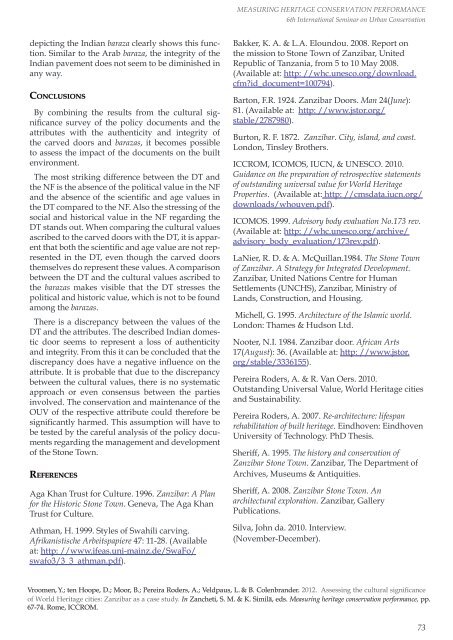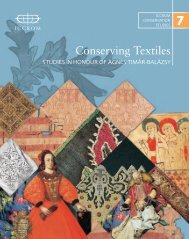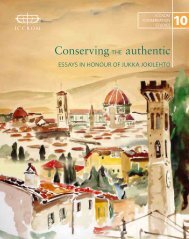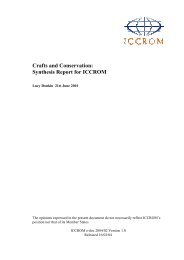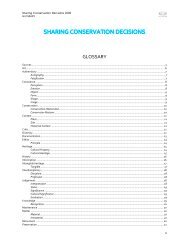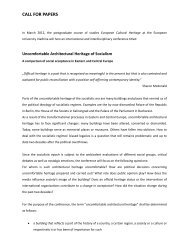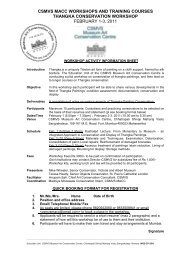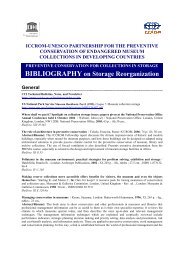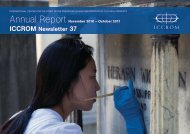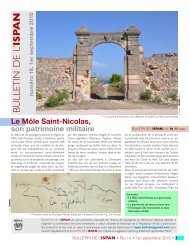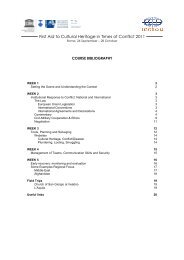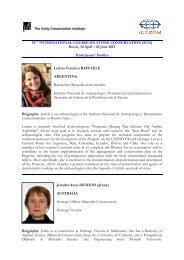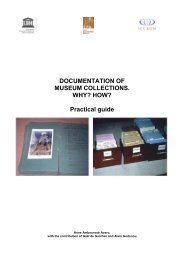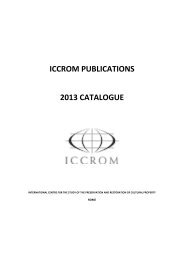part 1 - Iccrom
part 1 - Iccrom
part 1 - Iccrom
You also want an ePaper? Increase the reach of your titles
YUMPU automatically turns print PDFs into web optimized ePapers that Google loves.
MEASURING HERITAGE CONSERVATION PERFORMANCE<br />
6th International Seminar on Urban Conservation<br />
depicting the Indian baraza clearly shows this function.<br />
Similar to the Arab baraza, the integrity of the<br />
Indian pavement does not seem to be diminished in<br />
any way.<br />
Conclusions<br />
By combining the results from the cultural significance<br />
survey of the policy documents and the<br />
attributes with the authenticity and integrity of<br />
the carved doors and barazas, it becomes possible<br />
to assess the impact of the documents on the built<br />
environment.<br />
The most striking difference between the DT and<br />
the NF is the absence of the political value in the NF<br />
and the absence of the scientific and age values in<br />
the DT compared to the NF. Also the stressing of the<br />
social and historical value in the NF regarding the<br />
DT stands out. When comparing the cultural values<br />
ascribed to the carved doors with the DT, it is apparent<br />
that both the scientific and age value are not represented<br />
in the DT, even though the carved doors<br />
themselves do represent these values. A comparison<br />
between the DT and the cultural values ascribed to<br />
the barazas makes visible that the DT stresses the<br />
political and historic value, which is not to be found<br />
among the barazas.<br />
There is a discrepancy between the values of the<br />
DT and the attributes. The described Indian domestic<br />
door seems to represent a loss of authenticity<br />
and integrity. From this it can be concluded that the<br />
discrepancy does have a negative influence on the<br />
attribute. It is probable that due to the discrepancy<br />
between the cultural values, there is no systematic<br />
approach or even consensus between the <strong>part</strong>ies<br />
involved. The conservation and maintenance of the<br />
OUV of the respective attribute could therefore be<br />
significantly harmed. This assumption will have to<br />
be tested by the careful analysis of the policy documents<br />
regarding the management and development<br />
of the Stone Town.<br />
References<br />
Aga Khan Trust for Culture. 1996. Zanzibar: A Plan<br />
for the Historic Stone Town. Geneva, The Aga Khan<br />
Trust for Culture.<br />
Athman, H. 1999. Styles of Swahili carving.<br />
Afrikanistische Arbeitspapiere 47: 11-28. (Available<br />
at: http: //www.ifeas.uni-mainz.de/SwaFo/<br />
swafo3/3_3_athman.pdf).<br />
Bakker, K. A. & L.A. Eloundou. 2008. Report on<br />
the mission to Stone Town of Zanzibar, United<br />
Republic of Tanzania, from 5 to 10 May 2008.<br />
(Available at: http: //whc.unesco.org/download.<br />
cfm?id_document=100794).<br />
Barton, F.R. 1924. Zanzibar Doors. Man 24(June):<br />
81. (Available at: http: //www.jstor.org/<br />
stable/2787980).<br />
Burton, R. F. 1872. Zanzibar. City, island, and coast.<br />
London, Tinsley Brothers.<br />
ICCROM, ICOMOS, IUCN, & UNESCO. 2010.<br />
Guidance on the preparation of retrospective statements<br />
of outstanding universal value for World Heritage<br />
Properties. (Available at: http: //cmsdata.iucn.org/<br />
downloads/whouven.pdf).<br />
ICOMOS. 1999. Advisory body evaluation No.173 rev.<br />
(Available at: http: //whc.unesco.org/archive/<br />
advisory_body_evaluation/173rev.pdf).<br />
LaNier, R. D. & A. McQuillan.1984. The Stone Town<br />
of Zanzibar. A Strategy for Integrated Development.<br />
Zanzibar, United Nations Centre for Human<br />
Settlements (UNCHS), Zanzibar, Ministry of<br />
Lands, Construction, and Housing.<br />
Michell, G. 1995. Architecture of the Islamic world.<br />
London: Thames & Hudson Ltd.<br />
Nooter, N.I. 1984. Zanzibar door. African Arts<br />
17(August): 36. (Available at: http: //www.jstor.<br />
org/stable/3336155).<br />
Pereira Roders, A. & R. Van Oers. 2010.<br />
Outstanding Universal Value, World Heritage cities<br />
and Sustainability.<br />
Pereira Roders, A. 2007. Re-architecture: lifespan<br />
rehabilitation of built heritage. Eindhoven: Eindhoven<br />
University of Technology. PhD Thesis.<br />
Sheriff, A. 1995. The history and conservation of<br />
Zanzibar Stone Town. Zanzibar, The De<strong>part</strong>ment of<br />
Archives, Museums & Antiquities.<br />
Sheriff, A. 2008. Zanzibar Stone Town. An<br />
architectural exploration. Zanzibar, Gallery<br />
Publications.<br />
Silva, John da. 2010. Interview.<br />
(November-December).<br />
Vroomen, Y.; ten Hoope, D.; Moor, B.; Pereira Roders, A.; Veldpaus, L.·& B. Colenbrander. 2012. Assessing the cultural significance<br />
of World Heritage cities: Zanzibar as a case study. In Zancheti, S. M. & K. Similä, eds. Measuring heritage conservation performance, pp.<br />
67-74. Rome, ICCROM.<br />
73


